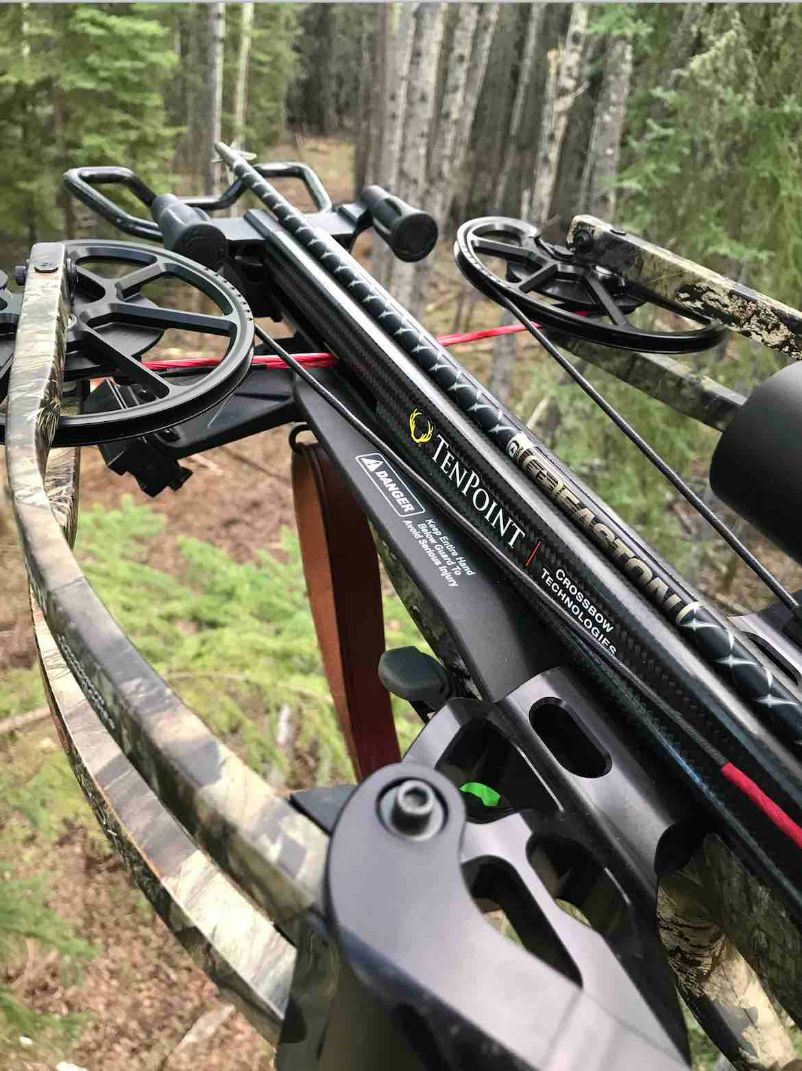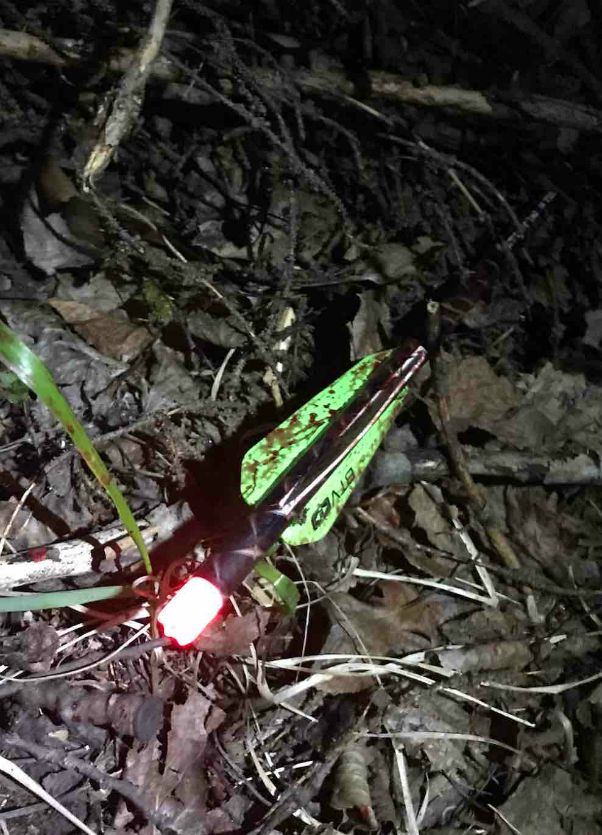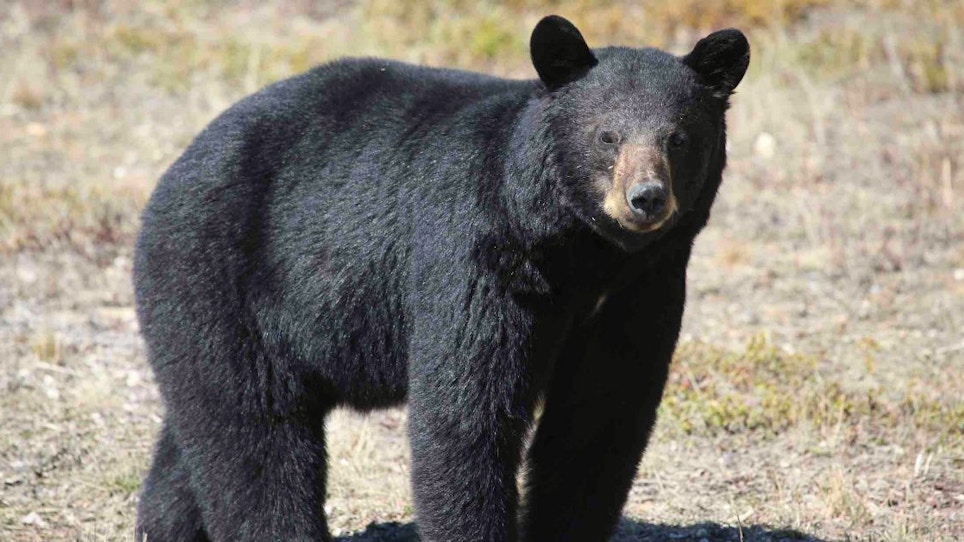
Knowing the stealthy habits of a mature bruin, the author kept his TenPoint Nitro RDX ready. Because he did, his hunt ended with a chance at a trophy black bear.
Situated in a mature spruce, I sensed movement behind me and to the right. I dared not move. Seconds later, a sly black bear edged into the periphery of my vision. The bear was timid and checked things out closely — I knew I needed to pull out my best statue impersonation or he would bolt. The bruin’s keen senses told him something wasn’t right, and he did leave momentarily, only to return minutes later to satisfy his hunger. Using the advantages of a crossbow to its fullest, I had set up a shooting stick and had my bow pointed in the direction I expected to shoot if a bear came in. My pre-planning paid off when the big boar sauntered across the game trail and into my shooting lane. I wasted little time placing my crosshair on his vitals and tightening up on the trigger of my TenPoint Nitro RDX.
My bolt passed completely through the bear before he even reacted. He let out a large roar and spun to run back in the direction from which he came, throwing moss and debris as if in four-wheel drive. The bear made it only 20 yards before piling up and bringing an end to another successful spring bear hunt.
Angled vs. Ground
Preparing for a spring bear hunt means practicing at the different shot angles you may be faced with in the field. Knowing I’d be hunting out of a treestand, I shot 3-D bear targets from a ladder stand to ensure proper angle and shot placement.
I’ve hunted many bears at eye level and harvested a beautiful black bear the previous spring from a ground blind. Many avid bowhunters believe a shot at ground level is much more efficient in cleanly harvesting a black bear. When you take the angle of your bolt placement out of the equation, it is much easier to target the vitals with a clean pass-through. Tracking becomes much easier, and bears tend to go shorter distances. Seasoned bear outfitters often convince clients to hunt bears at ground level, declaring higher kill and recovery rates.
Whether you hunt from an elevated perch or from the ground, practice, practice and practice some more. Most botched treestand shots on bears are simply due to the fact that the shooter doesn’t add the angle as part of the overall shot equation. Ground blind debacles simply come from a lack of focus — a shoulder and shoot without letting the crosshairs settle. Focused practice sessions can alleviate big-bear mishaps.
Clearance and Setup
Whether hunting out of a ground blind or treestand, always shoulder your bow and check for clearance in all possible directions. There is nothing worse than having the bear of your dreams walk in from an unexpected direction (it happens … a lot) and not having a shot. Whether you’re shooting forward or reverse limbs, it’s easy to measure the distance of your uncocked bow to check for clearance in any hunting situation. Simply mark an arrow with the total uncocked width and use the arrow to determine potential shooting lanes. Bears tend to rattle the nerves of hunters, and unsuspecting limb obstructions are often overlooked in the heat of the moment.
Part of your setup should include shooting sticks, a SteddyEddy or a rail. Having a big bruin so close that you can see their eyes can cause a nervous shake. A rest will help you stay on target.
 The Little Things
The Little Things
Black bears are one of the most difficult animals to decipher a crosshair against. The hide of a black bear can eat a black reticle, making it next to impossible to define your mark. An illuminated reticle, where legal, offers pinpoint accuracy. The illuminated reticle can be a game changer in a dark forest and in fading light against a very black backdrop.
Ranging your surroundings when you get in the stand will help you to reduce movement when a bear shows up. Range game trails and landmarks to predetermine shot opportunities without having to lift optics or your arm when a bear is on high alert and coming in. Bears, especially the big ones, don’t miss much. Just because you’re 20 feet off the ground or ducked into the corner of a dark ground blind doesn’t make you invisible to a bruin.
Bushnell makes a rangefinder that works on black objects and is specifically designed to help black bear and moose hunters that may have trouble getting a reading on a dark, non-reflective animal. The Trophy Extreme with ARC Bow Mode makes angle range compensation easy. Full Spectrum Targeting was designed to read dark or shaded objects, providing a range reading every time.
An illuminated nock, such as an Omni-Nock or Nockturnal, can take the guesswork out of where your shot hit the bear. The lights show up extremely well against black fur or any color phase. Using an illuminated nock can tell you if your bolt hits in the perfect location as it’s entering the bear. Being able to visualize where your bolt entered an animal also tells you where it might have exited or got hung up against dense bone. In cases where a bolt does stay in a bear, an illuminated nock can make retrieval in the dark woods easier.
 Kinetic Energy
Kinetic Energy
Black bears come in many shapes, sizes and colors. However, a trophy-class bruin is going to be a massive, muscular animal. A mature boar can often measure 7 feet from the nose to the hind foot with a chest cavity as big as an elk or a moose. Add the fact that black bears are considered dangerous game, and it just makes more sense to set up to maximize your broadhead penetration.
Long fur and hulking bodies make it difficult to decipher the kill zone, meaning you could catch extra bone on entry or exit. To ensure penetration and a complete pass-through, increase the total weight of your projectile. Several companies offer 125-grain broadheads for today’s high-speed crossbows. There are also some great options for heavier bolts, including Easton’s Full Metal Jacket.
Keep Control
Much has been written about “buck fever.” The only thing worse is “bear fever.” Many hunters get an elevated heart rate, shaky hands and vibrating extremities. If this occurs, do not try to rush a shot thinking the bear will only be there for a few seconds. On most spring baited hunts, a bear that comes to an established site will settle down and find its comfort zone. You have lots of time. An excited hunter needs to get control of the jitters to ensure the best shot possible and take home their spring trophy.
Images by Brad Fenson






